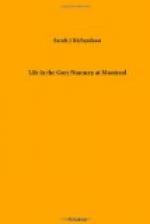I will not finish this narrative without telling the reader that the curate of the place appeared much incensed at what his parishioners had done. I am glad to be able to suppose that he condemns rather than encourages such conduct. A Protestant friend of mine who does not entertain the same respect for the Roman clergy that I do, advances the opinion that the displeasure of the curate was not on account of the culpable attempt of some of his flock but on account of its failure. However, I must add, on my reputation as a faithful narrator, that nothing has yet happened to confirm his assertion.
ERASTE D’ORSONNENS.
Montreal, September 1855.
APPENDIX II.
Cruelty of Romanists.
To show that the Romish priests have in all ages, and do still, inflict upon their victims cruelties quite as severe as anything described in the foregoing pages, and that such cruelties are sanctioned by their code of laws, we have only to turn to the authentic history of the past and present transactions of the high functionaries of Rome.
About the year 1356, Nicholas Eymeric, inquisitor-general of Arragon, collected from the civil and canon laws all that related to the punishment of heretics, and formed the “Directory of Inquisitors,” the first and indeed the fundamental code, which has been followed ever since, without any essential variation. “It exhibits the practice and theory of the Inquisition at the time of its sanction by the approbation of Gregory 13th, in 1587, which theory, under some necessary variations of practice, still remains unchanged.”
From this “Directory,” transcribed by the Rev. Wm. Rule of London, in 1852, we extract a few sentences in relation to torture.
“Torture is inflicted on one who confesses the principal fact, but varies as to circumstances. Also on one who is reputed to be a heretic, but against whom there is only one witness of the fact. In this case common rumor is one indication of guilt, and the direct evidence is another, making altogether but semi-plenar proof. The torture may bring out fall proof. Also, when there is no witness, but vehement suspicion. Also when there is no common report of heresy, but only one witness who has heard or seen something in him contrary to the faith. Any two indications of heresy will justify the use of torture. If you sentence to torture, give him a written notice in the form prescribed; but other means be tried first. Nor is this an infallible means for bringing out the truth. Weak-hearted men, impatient at the first pain, will confess crimes they never committed, and criminate others at the same time. Bold and strong ones will bear the most severe torments. Those who have been on the rack before bear it with more courage, for they know how to adapt their limbs to it, and they resist powerfully. Others, by enchantments, seem to be




